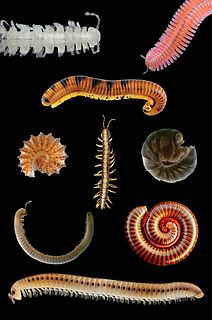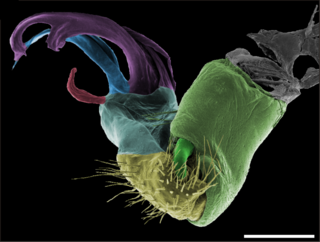 W
WCerci are paired appendages on the rear-most segments of many arthropods, including insects and symphylans. Many forms of cerci serve as sensory organs, but some serve as pinching weapons or as organs of copulation. In many insects, they simply may be functionless vestigial structures.
 W
WMillipedes are a group of arthropods that are characterised by having two pairs of jointed legs on most body segments; they are known scientifically as the class Diplopoda, the name being derived from this feature. Each double-legged segment is a result of two single segments fused together. Most millipedes have very elongated cylindrical or flattened bodies with more than 20 segments, while pill millipedes are shorter and can roll into a ball. Although the name "millipede" derives from the Latin for "thousand feet", no known species has 1,000; the record of 750 legs belongs to Illacme plenipes. There are approximately 12,000 named species classified into 16 orders and around 140 families, making Diplopoda the largest class of myriapods, an arthropod group which also includes centipedes and other multi-legged creatures.
 W
WCyphopods, also known as vulvae, are paired sacs in female millipedes that located on the underside of the third body segment that store sperm and connect to the oviduct. Cyphopods are sclerotized, and usually hidden behind a small opening. Despite the connotation of the suffix -pod, cyphopds are not derived from walking legs.
 W
WMillipedes are a group of arthropods that are characterised by having two pairs of jointed legs on most body segments; they are known scientifically as the class Diplopoda, the name being derived from this feature. Each double-legged segment is a result of two single segments fused together. Most millipedes have very elongated cylindrical or flattened bodies with more than 20 segments, while pill millipedes are shorter and can roll into a ball. Although the name "millipede" derives from the Latin for "thousand feet", no known species has 1,000; the record of 750 legs belongs to Illacme plenipes. There are approximately 12,000 named species classified into 16 orders and around 140 families, making Diplopoda the largest class of myriapods, an arthropod group which also includes centipedes and other multi-legged creatures.
 W
WCentipedes are predatory arthropods belonging to the class Chilopoda of the subphylum Myriapoda, an arthropod group which also includes millipedes and other multi-legged creatures. Centipedes are elongated metameric creatures with one pair of legs per body segment. Most centipedes are generally venomous and can inflict painful bites, injecting their venom through pincer-like appendages known as forcipules. Despite the name, centipedes can have a varying number of legs, ranging from 30 to 354. Centipedes always have an odd number of pairs of legs. Therefore, no centipede has exactly 100 legs. Similar to spiders and scorpions, centipedes are predominantly carnivorous.
 W
WIn arthropods, the maxillae are paired structures present on the head as mouthparts in members of the clade Mandibulata, used for tasting and manipulating food. Embryologically, the maxillae are derived from the 4th and 5th segment of the head and the maxillary palps; segmented appendages extending from the base of the maxilla represent the former leg of those respective segments. In most cases, two pairs of maxillae are present and in different arthropod groups the two pairs of maxillae have been variously modified. In crustaceans, the first pair are called maxillulae.
 W
WGonopods are specialized appendages of various arthropods used in reproduction or egg-laying. In males, they facilitate the transfer of sperm from male to female during mating, and thus are a type of intromittent organ. In crustaceans and millipedes, gonopods are modified walking or swimming legs. Gonopods may be highly decorated with elaborate structures which may play roles in sperm competition, and can be used to differentiate and identify closely related species. Gonopods generally occur in one or more pairs, as opposed to the single (un-paired) reproductive organs such as the aedeagus of insects or the penis of harvestmen.
 W
WTömösváry organs, also known as temporal organs or postanntennal organs are specialized paired sensory organs found in certain groups of myriapods and hexapods, located on the head near the base of the antennae. Various function of Tömösváry organs have been proposed, including sensing vibration, humidity, or light, although evidence for their true function is conflicting, and in groups such as millipedes its true function is unknown. The organs were first described by Hungarian biologist Ödön Tömösváry in 1883.
 W
WAn ozopore is the opening of a defensive gland present in some arthropods, notably in millipedes of the order Polydesmida and in harvestmen, the eight-legged arachnids also known as "daddy long-legs". The glands themselves are known as ozadenes, also called "scent glands", "repugnatorial glands", "odoriferous glands" or "stink glands" by various authors. The name is derived from Ancient Greek ozo "smell" and Latin porus "pore, small opening".
 W
WA tergum is the dorsal ('upper') portion of an arthropod segment other than the head. The anterior edge is called the base and posterior edge is called the apex or margin. A given tergum may be divided into hardened plates or sclerites commonly referred to as tergites.